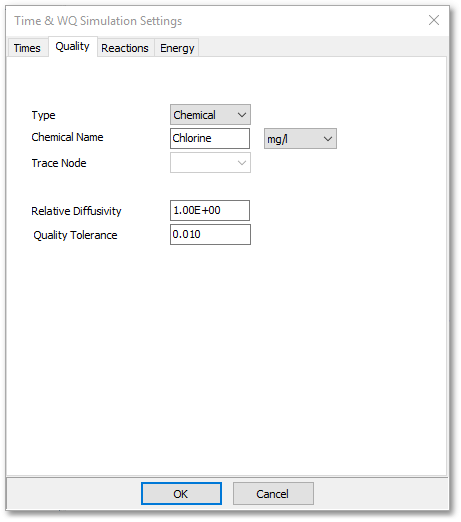The Quality tab of the Time & WQ Simulation Settings dialog box controls how the water quality analysis is carried out. The inputs consist of the following Water Quality Settings:

•Type: Type of water quality parameter being modelled. Choices include:
- None (no quality analysis),
- Chemical (compute chemical concentration),
- Age (compute water age),
- Trace (trace the percent of flow originating from a specific node).
In lieu of Chemical, the user can enter the actual name of the chemical being modelled (e.g., Chlorine) in the Chemical Name text box (as shown in the above screen-shot).
•Trace Node: ID label of the node whose flow is being traced. Applies only to flow tracing analyses.
•Relative Diffusivity: Ratio of the molecular diffusivity of the chemical being modelled to that of chlorine at 20° C. Use 2 if the chemical diffuses twice as fast as chlorine, 0.5 if half as fast, etc. Applies only when modelling mass transfer for pipe wall reactions. Set to zero to ignore mass transfer effects.
•Quality Tolerance: Smallest change in quality that will cause a new parcel of water to be created in a pipe. A typical setting might be 0.01 for chemicals (measured in mg/L), as well as for water age and source tracing.
Note: The Quality Tolerance determines when the quality of one parcel of water is essentially the same as another parcel. For chemical analysis, this might be the detection limit of the procedure used to measure the chemical, adjusted by a suitable factor of safety. Using too large a value for this tolerance might affect simulation accuracy. Using too small a value will affect computational efficiency. Some experimentation with this setting might be called for.